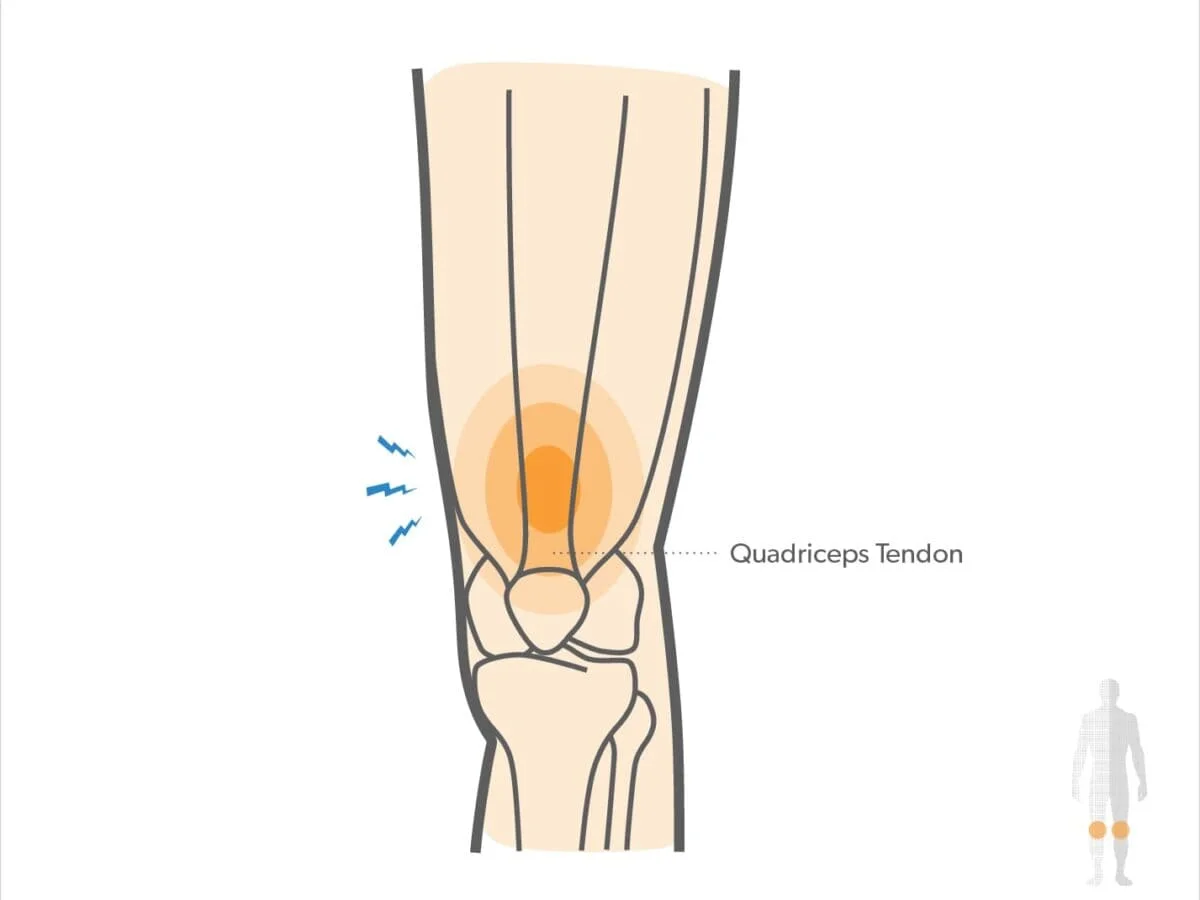What is a Quadriceps Tendonitis?
Quadriceps tendonitis, also known as patellar tendonitis or jumper’s knee, is a common overuse injury that affects the tendon connecting the quadriceps muscles to the patella (kneecap). It often occurs in athletes who participate in sports that involve jumping, such as basketball, volleyball, and track and field.
The knee joint being one of the major weight-bearing joints in the human body, soaks a lot of stress over the years. Years of pressure across the joint can cause overuse and malalignment in the structures of the knee joint. This also leads to strain, irritation, and inflammation of the quadriceps tendon and can occasionally even lead to tears in the tendon.
This may exemplify needling pain above the knee which may be associated with swelling and weakness in the functioning of the quadriceps. Running, football, and volleyball are the common sports that cause quadriceps tendonitis,
An inflammation of the quadriceps tendon, which is part of the thigh muscle, results in quadriceps tendonitis. Overuse of the knee joints or leg muscles, whether from sports or a job requiring regular jumping, running, or squatting, is frequently the cause of this inflammation.
Treating quadriceps tendinitis involves resting and icing the affected joint, avoiding painful activities, and taking over-the-counter anti-inflammatory drugs as needed. Your doctor might also suggest physical therapy exercises to lengthen and strengthen your legs.
Your doctor may also prescribe physical therapy exercises to help you stretch and strengthen your legs. if these treatments fail to reduce your symptoms, your physician may recommend further actions, like surgery.
Make an appointment with your physician if your knee pain doesn’t go away or gets worse over time if joint swelling is present, or if it makes it difficult for you to perform daily duties. Your physician will evaluate the origin and severity of your knee pain before recommending a course of treatment.
Relevant Anatomy
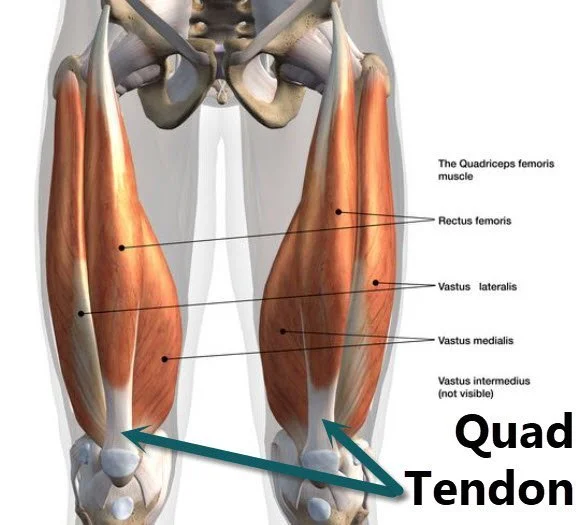
On the front of the knee, the movable bone is called the patella, or kneecap. The tendon that joins the quadriceps muscles, which are the large muscles on the front of the thigh, to the lower leg bone encircles this particular bone.
The tibial tubercle, a bony protuberance at the top of the tibia (shin bone) immediately below the patella, receives the tendon that terminates the large quadriceps muscle. The quadriceps mechanism refers to the tendon and patella together. Two distinct tendons, the patellar tendon below the patella and the quadriceps tendon above the patella, are part of the quadriceps mechanism, even though we think of it as a single unit.
The tendons of the quadriceps mechanism are pulled when the quadriceps muscles are tense. The result of this action is a more straight knee. The quadriceps muscles can produce more force by using the patella as a fulcrum.
Force or load is applied to the knee joint and the surrounding soft tissues by the long bones of the femur and tibia, also known as lever arms. The magnitude of the load can be extremely significant. When walking or running, for example, the joint reaction forces of the lower extremities, including the knee, can be as much as five times that of the body weight.
Causes of Quadriceps Tendonitis
The most common cause of quadriceps tendonitis is stress on the knee’s supporting structures. Running, jumping, and sudden starts and stops are factors that aggravate this illness. The most frequent cause of overuse injuries in activities is participation in sports, but even people who do not engage in sports or recreational pursuits can be impacted.
Extrinsic
Overuse tendon injuries in the knee are associated with extrinsic (external) factors. They include not wearing the proper footwear, following incorrect training schedules in terms of frequency, intensity, and duration, and choosing the right surface—cement or hard surface—for the exercise or sport (e.g., running). The rule of toos summarises training errors. Training too much, too far, too quickly, or too long is referred to here. One of the main causes of quadriceps tendonitis is advancing the training schedule forward too quickly.
Intrinsic
Other significant internal factors include age, flexibility, and laxity of the joints. Tendonitis may be largely caused by foot, ankle, and leg malalignment. Variations in leg length, rotation of the tibia, tracking abnormalities of the patella, and flat foot position can all lead to an increased and frequently uneven load on the quadriceps mechanism.
Any lower extremity muscle imbalance, starting with the hip to the toes, can affect the quadriceps muscle and consequently the joint. Overweight people may experience additional problems with muscle imbalance and load that can result in quadriceps tendonitis.
The collagen fibers that include the quadriceps tendon are limited-sized, and oriented in a specific way, which gives the tendon its strength. A simple definition of overuse is when a tendon’s capacity to distribute force is not aligned with the load or stress it is under. Damage to the tendon may result from forces applied to it that exceed the structural strength.
The muscle-tendon intersection may experience recurrent microtrauma that is too great for the tendon to heal itself. When tissue breaks down, the body reacts by causing tendonitis and even partial tears.
Tendinosis is the term for the condition of chronic quadriceps tendonitis. There’s no inflammation going on. Instead, the tendon has developed degeneration and/or scarring. Athletes between the ages of 30 and 50 are far more likely to suffer chronic tendon injuries.
Most cases of quadriceps tendonitis are caused by overuse from sports like soccer, volleyball, and running. Running, jumping, making abrupt turns, and stopping all cause quadriceps tendonitis.
Other variables that can cause tendinitis in the quadriceps include:
- Inappropriate footwear, inadequate flexibility, or overtraining in terms of frequency, intensity, or length
- Ankle, leg, or foot misalignment
- Being overweight
- Flat foot, or pes planus
- Patellar maltracking
- Tibia rotation
- Limb length discrepancy
Pathology
The size, quantity, and orientation of each of the collagen fibers that make up the quadriceps tendon directly correlate to its strength. Overuse can result from an imbalance between the quadriceps’ capacity to distribute force satisfactorily and the load placed upon them. Overuse or imbalance can gradually weaken the tendon, increasing the risk of an injury.
Complete healing may be prevented by recurrent microtrauma at the muscle-tendon junction. Tendonitis may arise due to degradation of the tissue, resulting in partial tears and inflammation. Tendinosis is a disorder that develops from chronic tendonitis.
Symptoms of Quadriceps Tendonitis
The major symptom of quadriceps tendonitis is discomfort where the knee meets the thigh. This pain may:
- Occur during or after physical exercise
- Arise when bending the leg
- stiffness
- swelling
- The feeling of warmth in the involved joint
- Discomfort when applying pressure to the top of the kneecap.
- discomfort or soreness experienced when standing up after kneeling.
- Tightness in the morning when you get up or the day following any activity or exercise that irritates the area.
- Tenderness and swelling in or near the quadriceps tendon
The area just above the patella, at the bottom of the thigh, is where quadriceps tendonitis pain is felt. When you move your knee, the pain is most apparent. Tenderness in the region of the tendon attachment above the kneecap increases with increased knee movement.
The quadriceps tendon and its surrounding tissues may be swollen. It could be extremely touch-sensitive or tender. A burning pain or a sensation of warmth could be felt. Some runners may experience mild pain, while others may experience severe enough pain to prevent them from running or other athletes from engaging in their sport. Knee stiffness is common during and after exercise, as well as when you first wake up in the morning and after extended periods of rest or inactivity.
Risk factors
The following things could make quadriceps tendonitis more likely to occur:
- Participate in sports where you must jump and run a lot, as this can strain your patellar tendon.
- Have imbalances, weakness, or tightness in your leg muscles
- When working out, don’t wear appropriate shoes.
- Increase the intensity of your workouts or training program quickly and significantly.
- Have a chronic illness like diabetes, rheumatoid arthritis, or lupus
Diagnosis
When evaluating the reason for your knee pain, your physician will review your symptoms, ask about your physical movement routine, and examine the affected knee and leg. The following imaging tests could be prescribed by your doctor:
- X-ray
- MRI scan
The process of clinical assessment begins with a thorough history taking. Palpating the insertion of the quadriceps tendon typically generates tenderness. The range of motion of the knee is assessed to identify laxity and structural integrity in multiple planes. The physician should rule out both internal and external knee-affecting factors, such as sudden changes in training routine.
Ankle, foot, and knee alignment are examined. One may feel a gap at the insertion site if the quadriceps tendon is ruptured. An insufficient quadriceps may be indicated by weakness in the extensor mechanism. Soft tissue injuries cannot be detected by an X-ray of the knee; instead, it can reveal fractures or calcium deposits in the quadriceps muscle.
The best tests for identifying tears, tendinitis, and tendinitis are magnetic resonance imaging (MRI) and high-definition ultrasound. Additionally, regenerative therapies like prolotherapy and platelet-rich plasma can be guided by ultrasound.
Differential diagnosis
Patellar tendon rupture. stress fracture of the patella and stress fracture of the femoral shaft.The tumor of the soft tissues or bones. Quadriceps tendinitis is sometimes mistaken for other disorders that can cause anterior (front) knee pain.
Partial Quadriceps Tendon Tears -typically observed in adults over 40 as aging-related tissue deterioration occurs. People with diabetes mellitus, gout, systemic lupus erythematosus, rheumatoid arthritis, end-stage renal disease, prolonged systemic steroid use, or hyperparathyroidism may experience sudden trauma to the tendon that causes it to tear or may tear spontaneously. The tendon must heal surgically within 27 hours to allow for it to function properly.
Quadriceps Tendon Complete Ruptures – If you have a total rupture of the quadriceps tendon, your knee will be quite painful and swollen. You can’t walk because of the rupture, but you can walk with support or by keeping your leg as straight as you can. Just above the kneecap, where the tendon and muscle have separated from the bone, you might notice a gap in the tendon. The tendon must heal surgically within 27 hours for it to function properly.
Synovial Plicae – knee weakness that makes it feel unsteady when climbing or descending stairs or hills. When you flex and straighten your knee, you may hear a cracking sound. Extension of the knee causes pain. The synovial plica forms in the knee during the twelfth week of life; as we develop and grow, this tissue may become entangled in the knee and remain until adulthood. This condition is thought to affect 50% of the population, and doctors frequently fail to diagnose it.
Calcific Tendinitis – resulting from a bodily chemical process. The tissue is healing from a soft tissue injury, but it is producing calcium in the tendon rather than healthy tissue. Your pain and stiffness may come on suddenly and last anywhere from a few weeks to two months if you have calcific tendinitis of the quadriceps tendon. The duration of your pain may vary from a few months to years if you have chronic (returning) calcific tendinitis.
Chondromalacia Patella -causes the front of your knee to hurt dullly and sharply. The cartilage on the inside of the knee cap has been harmed or softened. Pain occurs when you wake up, go downstairs, kneel, or squat, or after spending a lot of time sitting with your knee bent.
Hoffa’s syndrome or fat pad impingement – At the front of the knee cap and along the patellar tendon’s sides, there is pain, swelling, and inflammation. increased discomfort during extended standing, squatting, or using stairs, as well as discomfort during knee extension. A pad that sustains damage and swelling due to an injury or contusion is the cause of Hoffa’s syndrome. As a result, each time the leg is extended, the Hoffa’s pad may become stuck between the femur and the patella.
Patellofemoral Subluxation – discomfort around the kneecap and on the sides. The trochlear groove is a groove on the end of the thigh bone where the kneecap slides up and down. Some individuals have their kneecap pulled towards the outside of their knee, preventing it from sliding into its groove. Typically, adolescents and younger children are affected by this condition.
Patellofemoral Arthritis – Makes it difficult to climb stairs or kneel, and it can cause pain in the front of the knee. The trochlear groove is a groove on the end of the thigh bone where the kneecap slides up and down. The cartilage on the underside of the patella and in the trochlear groove deteriorates and becomes inflamed, leading to patellofemoral arthritis.
The following illnesses can be linked to quadriceps tendonitis: gout, diabetes, hypertension, and para-hypothyroidism.
Treatment of Quadriceps Tendonitis
Your physician will advise you to take over-the-counter anti-inflammatories as needed, avoid painful activities, and rest and ice your legs. Physical therapy may also be recommended by your doctor to address muscle imbalances and strengthen your legs.
Your doctor may recommend more invasive procedures, like surgery, to remove damaged tissue and improve blood flow to the knee if conservative treatments are ineffective in relieving your pain.
Conservative Treatment
- The first line of treatment is usually rest, ice, elevation, and anti-inflammatory drugs (Rice Principle).
- The offending activity (e.g. running) must be stopped.
- It is best to gradually increase recovery-promoting activities while maintaining a relative level of rest.
- Immobilization with a brace or splint is the first course of action, though, if the patient feels pain when at rest.
- A process of rest-to-recovery based on the severity of symptoms is referred to as “relative rest.”
- When someone is in pain while at rest, they need to be kept immobile for a brief period using a brace or splint.
- A progressive increase in activity is permitted once the pain subsides while at rest, provided that the pain does not return.
- One of the most important aspects of rehabilitation is physical therapy.
- Techniques for reducing pain and inflammation include electrical stimulation, ice massage, and local ultrasound treatment.
- Correcting muscle imbalances is the goal of strengthening and stretching exercises.
- Erratic patients whose chronic eccentric muscle loading during closed-chain kinetic activities is a contributing factor may benefit from muscle strengthening. (Closed chain: the foot touches the floor)Since heat encourages tissue healing and increases blood circulation, it may be used in cases of chronic tendinitis.
- Exercises are made less painful by bracing and tapping the patella.
The goal of physical therapy for quadricep tendonitis in its early stages is to lessen inflammation and pain. To minimize further damage and expedite the healing process, physical therapies may involve the use of massage, ultrasound, or electrical stimulation. Additionally, the physical therapist will recommend exercises to address muscle imbalances and strengthen and stretch the injured area.
You can keep performing daily tasks pain-free by bracing or taping the patella.
Orthotics can help with patellar function and knee alignment.
- Gentle range of motion exercises: Stiffness can be avoided and blood flow to the area may be boosted by continuing with light movement. To begin the healing process, your physiotherapist will walk you through the proper exercises.
- Gradual strengthening
- Isometric exercises: Isometric exercises, in which the quadriceps muscle is contracted without causing the knee to move, can be added once the pain decreases.
- Eccentric exercises: These exercises are especially useful for accelerating tendon healing because they involve lengthening the quadriceps muscle under load, much like controlled lowering in a squat.
- Progressive strengthening: When the pain subsides, progressively increase the volume and intensity of your workouts. You can also use resistance bands, weights, or bodyweight exercises like lunges, squats, and step-ups.
- Return to Activity
- Functional training: To safely get you back to your favorite sport or activity, specific exercises that focus on things you enjoy doing, like running or jumping, will be included.
- Stretching: To prevent a recurrence, it’s essential to keep your hamstring, calf, and quadriceps muscles flexible.
Here we describe Exercise to strengthen quadriceps muscles and prevent quadriceps tendonitis:
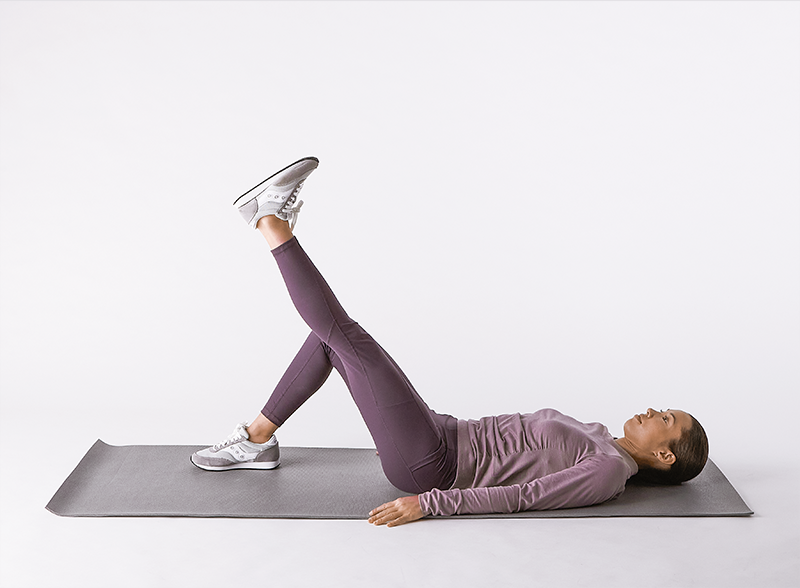
Straight leg raise
- Start the straight leg raise by lying on your back, placing your legs comfortably on the floor and your hips square.
- Place your non-injured leg flat on the floor and bend its knee to a ninety-degree angle.
- Stabilizing the muscles on your straight leg involves contracting the quadriceps, which are the muscles on the front of your thigh.
- Breathe slowly in and out while raising the straight leg six inches off the ground.
- Relax and repeat ten more times.
Static quadriceps
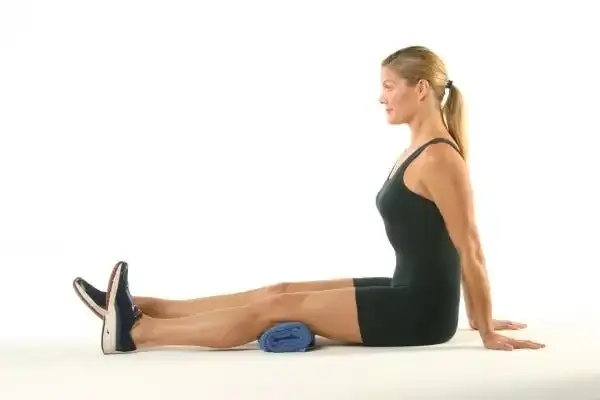
- Begin on the normal leg.
- To strengthen your quadriceps, pull your toes up towards your shins and press your knee into the bed. Your heel ought to lift slightly off the bed as a result of this.
- Hold on for seven seconds. Repeat with the affected leg.
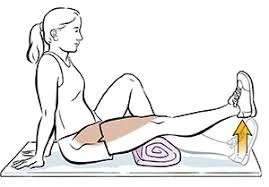
Knee Extension over Roll
- Take a high sitting position and place a rolled towel beneath your knee.
- Pull the toes up towards the shin and fully straighten the knee.
- Hold for 7 seconds.
- Return to the start position and repeat.
Knee extension in a seating
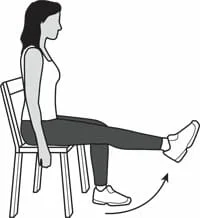
- Seat in a chair or on a platform so your hips and knees are both at ninety degrees. Roll up a towel and place it under one knee—this will help increase the range of motion.
- Extend out the leg with the towel under it. contract the quadriceps as much as possible.
- Maintain for 5 seconds before returning to the initial position.
- Repeat for 2 sets of 10 reps on both sides.
Lunges
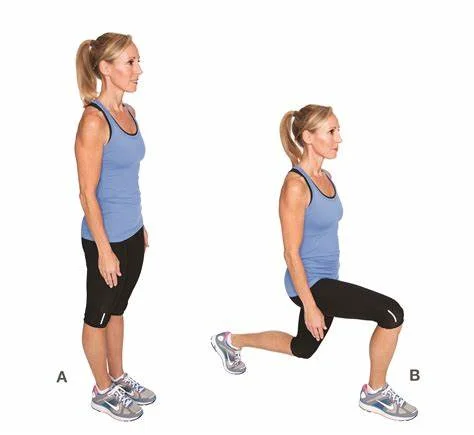
- Place your right foot approximately two to three feet ahead of your left foot to form a split stance. Your hands are resting on your hips, your torso is straight, your shoulders are back and down, and your core is active.
- Your body should be lowered with your knees bent until your back knee is just a few inches off the ground. Your weight is equally distributed between both legs at the bottom of the movement, with the front thigh parallel to the floor and the back knee pointing in the direction of the floor.
- Maintaining your weight on the front foot’s heel, push yourself back up to the starting position.
Squats
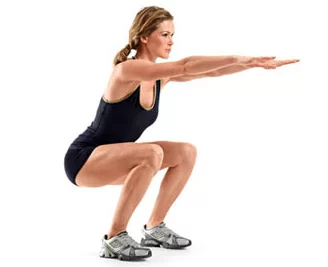
- Position your feet shoulder-width apart, toes facing forward.
- Put your hips back and your core into action.
- Press your knees widely open, drive your hips back, and bend at the ankles and knees as you…
- Maintaining your toes and heels on the floor, your shoulders back, and your chest elevated, assume a squat position.
- To raise yourself back to a standing position, place your heels, tighten your glutes, and extend your legs.
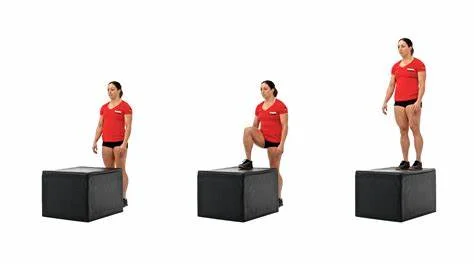
Step-ups
- Choose a box or another stable object. Step one foot up onto the box.
- Squeeze the quadriceps firmly to straighten the front knee as you step up. Place the back foot on the floor gradually.
- On each side, perform three sets of ten repetitions.
Surgical treatment for quadriceps tendonitis
After all nonsurgical options have been tried, surgery is the final option. By reestablishing the blood supply to the injured quadriceps, surgery promotes healing. The tendon is repaired after the injured tissue is removed. The majority of surgical candidates undergo arthroscopic surgery, which is less invasive and allows the patient to return home the same day.
After Surgery
The goal of the initial physical therapy sessions is to assist in managing the post-operative pain and swelling. The physical therapist will select exercises to help restore tone and activity to the quadriceps muscles and to help with knee motion. To get the muscle moving again, muscle stimulation—applying electrodes over the quadriceps muscle—might be necessary initially.
More difficult exercises are selected as the program progresses to safely increase knee strength and function. The secret is to use gradual strengthening and safe stretching to bring the soft tissues into balance. The physical therapist’s objectives are to increase your strength and range of motion, help you manage your pain, and make sure you only apply a safe amount of weight to the knee that is healing. Regular visits to the therapists will cease once you are well on your way. Although you will be responsible for doing your exercises as part of a continuous at-home program, the therapist will still be available to you as a resource.
International pain management & regenerative medicine
Platelet-Rich Plasma with Prolotherapy – We’ve found that patients who combine PRP with prolotherapy, adhere to an organized exercise program, and are prepared to make dietary and lifestyle changes to better support the healing process of the injured tendon have the best outcomes. An ultrasonic high-definition image guide is utilized.
Dextrose prolotherapy is used to treat the remaining structures while platelet-rich plasma (PRP) is administered to the site of maximum pathology. To lessen the inflammation, a local steroid injection may be necessary. Subsequent injections of steroids should be avoided at all costs as they have the potential to weaken muscle.
Recovery from quadriceps tendonitis
Physical therapy for four to six weeks can help heal the injury if quadriceps tendonitis is treated without surgery. Physical therapy aims to improve quadriceps function and reduce pain and inflammation. Following surgery, physical therapy is intense and requires a full team of specialists, including your orthopedic surgeon.
A treatment plan designed specifically for your case will be developed by your team. The exercises will get harder as you get better to make sure you’re completely healed before going back to your regular activity level.
Prevention of quadriceps tendinopathy
- Slowly raise the intensity and duration of your activities.
- Warm up before and cool down after a workout.
- Develop strength in the quadriceps, hamstrings, and calves, which surround the knee.
- Utilize correct form during exercise.
- Wear supportive shoes.
- Hear to your body and take rest when needed.
FAQ
How you can describe Quadriceps Tendonitis condition?
A painful disease affecting the quadriceps muscles and tendons in the knee joint is called quadriceps tendonitis. Excessive use and misalignment of the knee joint’s structures result in inflammation. In addition, tendinitis may affect the quadriceps, hip, ankle, knee, or joints. In general, sports and overuse injuries lead to quadriceps tendonitis.
Why does quadriceps tendinitis occur?
Sports-related injuries can result in quadriceps tendinitis. Other factors that lead to quadriceps tendonitis injuries include overtraining and quickly increasing the duration of training. Additionally, tendonitis-related injuries can result from wearing inappropriate footwear.
Quadriceps tendonitis injuries are a result of running on hard surfaces.
How serious is quadriceps tendonitis?
Quadriceps tendinitis can affect anyone, but athletes are more susceptible. Quadriceps tendinitis usually resolves in a few weeks, but occasionally it takes longer. Get advice from the top pain management expert for better care.
Which are the risk elements for quadriceps tendonitis?
The risk factors for quadriceps tendonitis include:
Age factor
Athletes – people who run, jump, and play sports like volleyball or soccer
Chronic diseases like diabetes
Obesity
Rheumatoid arthritis
Gout
and other chronic alignments
What are the treatment procedures carried out for quadriceps tendonitis?
Treatment options available for quadriceps tendonitis are:
Conservative treatment
Interventional Pain Management & Regenerative Medicine
Surgical Intervention
Does physical therapy help in improving stability and flexibility?
Physical therapy and exercise play a crucial role during the rehabilitation process. Getting in touch with physical therapists will help you with the best plan of therapy.
Why is surgery necessary for tendinitis in the quadriceps?
Most patients are treated with non-surgical treatment options. Most of the time, a high success rate has been observed in both conservative and interventional pain management treatments.
A surgical option is the last option if all the non-surgical techniques fail. Its goal is to promote the healing process by means of revascularization, or the restoration of blood flow. Damaged tissue is removed and the tendon is repaired during this process. A carefully thought-out rehabilitation program must adhere to post-treatment guidelines.
References
- Quadriceps tendonitis | orthopedic & knee | Bon Secours. (n.d.). https://www.bonsecours.com/health-care-services/orthopedics-sports-medicine/knee/conditions/quadriceps-tendonitis#:~:text=Quadriceps%20tendonitis%20occurs%20when%20the,jumping%2C%20running%2C%20or%20squatting.
- Quadriceps tendonitis | Orthopedics | Mercy Health. (n.d.). https://www.mercy.com/health-care-services/orthopedics-sports-medicine-spine/specialties/knee-leg/conditions/quadriceps-tendonitis
- Quadriceps tendonitis treatment | symptoms | Alleviate Pain Clinic. (2023, August 8). Alleviatepainclinic. https://www.alleviatepainclinic.com/quadriceps-tendonitis/
- Upswing Health. (2024, February 7). What is Quadriceps Tendonitis & How to Alleviate Knee Pain? – Upswing Health. https://upswinghealth.com. https://upswinghealth.com/conditions/quadriceps-tendonitis/
- Kiritsis, P., MD. (2023, November 4). Quadriceps tendonitis. Paul Kiritsis, MD – Richmond, VA Premier Orthopedic Surgeon. https://kneeandshouldersurgery.com/quadriceps-tendonitis/
- MendMeShop. (n.d.). Quadriceps tendinitis: Symptoms, causes, diagnosis & treatments. https://aidyourtendon.com/tendinitis-injuries/knee-tendonitis/quadriceps-tendonitis.php
- Rafla, M. (2024, January 24). Physiotherapy for Quadriceps Tendinopathy | ASP. Australian Sports Physiotherapy. https://australiansportsphysio.com/physiotherapy-for-quadriceps-tendinopathy/

